#dale steyn south africa
Explore tagged Tumblr posts
Text
IPL 2025: Dale Steyn quits as Sunrisers Hyderabad bowling coach

South Africa fast-bowling great Dale Steyn has announced that he will be quitting as the bowling coach of Sunrisers Hyderabad (SRH) ahead of the 2025 season of the Indian Premier League (IPL).
Source: bhaskarlive.in
0 notes
Text
Cricketing Giants Collide: Notable ODI encounters between South Africa and West Indies Analyzing Face-Offs
The cricketing competition among Notable ODI encounters between South Africa and the West Indies is one characterized by way of exhilarating suits, dramatic moments, and the display of extremely good expertise. Both groups have wealthy histories and have contributed notably to the game, every bringing their particular patterns and flair to the sport. This contention, even though not as longstanding as a few others in cricket, has furnished lovers with numerous memorable encounters.

Historical Context
South Africa and West Indies historical cricket rivalry The West Indies, a group representing a group of Caribbean international locations, commenced making their mark on global cricket within the early 1900s, but it become inside the Seventies and Eighties that they definitely ruled the sport. Their group, beneath the captaincy of Clive Lloyd and later Vivian Richards, changed into acknowledged for its aggressive batting, speedy bowling assault, and typical dominance in world cricket. During this period, the West Indies had been in reality unbeatable, showcasing a number of the quality skills the sport has ever visible.

South Africa’s tour of West Indies 2024 itinerary cricketing adventure, then again, turned into marked with the aid of a long duration of isolation due to the apartheid regime. The country was banned from international cricket from 1970 to 1991. After rejoining the cricketing fold in 1991, South Africa speedy hooked up itself as a major pressure in international cricket. With players like Allan Donald, Hansie Cronje, and later, Jacques Kallis and AB de Villiers, South Africa brought a brand new degree of competitiveness to the game.
Early Encounters
The first Test fit between South Africa and the West Indies occurred in 1992, shortly after South Africa's return to international cricket. The series was considerable as it marked South Africa’s reentry into the worldwide cricketing area. The West Indies, led by way of their bold group, had been a robust test for the newly reintegrated South Africans.
In that series, South Africa won the primary Test suit at the Wanderers Stadium in Johannesburg, putting the tone for a competitive series. The West Indies bounced again in the 2d Test, demonstrating their resilience. The collection ended in a 2-1 victory for the West Indies, with the fits showcasing the excessive degree of ability and competitive spirit that would define future encounters among the two teams.
Key Players and Performances
Over the years, each groups have been domestic to some of the finest cricketers inside the world. For the West Indies, players like Brian Lara, who holds the document for the highest individual score in Test cricket (four hundred not out), were crucial. Lara's performances towards South Africa had been frequently sport-changers, as he might consistently score massive runs and positioned the opposition below pressure.
Similarly, for South Africa, gamers like Jacques Kallis and Dale Steyn were instrumental of their cricketing achievement. Kallis, one of the greatest all-rounders within the history of cricket, has been a key figure in severa fits towards the West Indies, contributing with each bat and ball. Dale Steyn, recognized for his competitive speedy bowling, has often been the spearhead of South Africa's attack, supplying crucial breakthroughs and dismantling opposition batting line-ups.
Notable Matches
Several memorable suits have described the South Africa-West Indies rivalry. One such sport became the Test suit in Cape Town in 1999. South Africa, led through their captain Hansie Cronje, chased down a challenging target of 369 runs set by the West Indies. The suit is remembered for its dramatic end and the resilience proven by way of the South African crew.
In the One Day International (ODI) layout, the 2003 Cricket World Cup encounter among South Africa and the West Indies is in particular great. The healthy, held at Newlands in Cape Town, saw South Africa secure a win with the aid of a margin of 3 wickets. This victory changed into essential for South Africa, because it showcased their capacity to carry out beneath pressure in excessive-stakes games.
Another iconic fit turned into the T20 World Cup game in 2009, where the West Indies, led with the aid of their captain Darren Sammy, controlled to steady a win in opposition to South Africa. This in shape changed into sizeable as it highlighted the West Indies' prowess within the T20 layout, in the end leading them to win the event.
The Modern Era
In latest years, the contention has persevered to be aggressive, although the nature of the contests has evolved with modifications in the game. South Africa has remained a strong force in international cricket, whilst the West Indies have skilled a extra fluctuating period. Despite this, encounters between the 2 groups are always predicted with exhilaration.
The evolution of the sport, consisting of the upward push of T20 leagues like the IPL and CPL, has added a new measurement to the rivalry. Players from both teams now frequently compete towards every other in these leagues, adding a layer of intrigue to their international encounters. The affect of these leagues has delivered a new fashion of play, blending aggressive batting with modern strategies, which regularly reflects inside the worldwide video games.
Impact and Legacy
The South Africa-West Indies cricket live streaming options contention has had a considerable effect on the game of cricket. It has contributed to the development of the game by using showcasing numerous kinds of play and introducing fanatics to tremendous cricket. The matches among these teams have regularly been a show of skill, method, and sportsmanship.
Both groups have a rich legacy of manufacturing cricketing legends and providing enthusiasts with thrilling matches. Their encounters continue to be a spotlight of international cricket, celebrated for their competitive spirit and the excessive level of performance.
#South Africa-West Indies cricket live streaming options#South Africa’s tour of West Indies 2024 itinerary#South Africa and West Indies historical cricket rivalry#Notable ODI encounters between South Africa and the West Indies
2 notes
·
View notes
Text
Bumrah reaches 200 wickets with the best average in Test cricke
No bowler before Jasprit Bumrah has reached 200 wickets with an average of less than 20. For a bowler whose Test career is filled with stunning dismissals, Bumrah’s 200th wicket was relatively simple – Travis Head flicking straight to midwicket. However, Bumrah reached this milestone with remarkable statistics, solidifying his place among the greatest bowlers. / Out of the 85 bowlers who have taken 200 or more Test wickets, 12 achieved this feat in fewer games than Bumrah, who was playing his 44th Test at the MCG. In terms of bowling average, Bumrah is at the top with an average of 19.56 per wicket. He is the first bowler to concede fewer than 4000 runs for his first 200 wickets. / Bumrah’s strike rate of 42.4 – a wicket every seven overs – is only surpassed by Waqar Younis, Dale Steyn, and Kagiso Rabada, all experts with both the new and old ball. / Bumrah’s record in South Africa, England, New Zealand, and Australia also stands out. He holds the highest percentage of wickets for an Indian fast bowler in these countries. Sixty-four of Bumrah’s first 200 wickets have been of top-three batters. He has dismissed openers 50 times (25%) and the number three batsman 14 times (7%). The number four position often represents the most renowned batter in the team, and Bumrah has dismissed the No. 4 batsman 30 times (15%). Bumrah’s percentage of top-four wickets (47%) is the seventh best overall and the best for India. Among all batters, Bumrah has dismissed Joe Root the most (nine times). Pat Cummins follows with eight dismissals, and Travis Head comes next with six, including two dismissals in the MCG Test. Bumrah’s excellence in all formats has meant India needs to carefully manage his workload. Since his debut in 2018, he has missed 18 out of 30 home Tests due to injuries or workload management, but only eight away Tests, primarily due to injury. As a result, 153 of his first 200 Test wickets have come away from home. His bowling average at home is superior to his away numbers, which are equally impressive. India’s focus on keeping Bumrah fit for high-profile matches has meant more games against Australia and England, the two teams against whom he has claimed the most wickets. The one team he has struggled against is New Zealand: an average of 45.44 with just nine wickets from five Tests. Bumrah averages an outstanding 14.4 for his 110 wickets in 20 Test wins for India. The next three Indian bowlers on this list, with a minimum of 100 wickets, are all spinners – Anil Kumble (18.75), R Ashwin (18.99), and Ravindra Jadeja (19.65).
More:https://cricinfo.cc/bumrah-reaches-200-wickets-with-the-best-average-in-test-cricke/
0 notes
Text
Milestone: Kagiso Rabada picks 300th Test wicket

South Africa speedster Kagiso Rabada scripted his name in cricketing history when he reached the 300 mark of Test wickets on October 21, 2024. That day would go down in record books as it added him to an elite club of those few who have brought individualism to Test bowling. Rabada's route to the 300 wickets mark is never one that stopped at phenomenal. He reached the milestone in his 65th Test, speaking a lot to his continuous excellence and dedication. At 11,817 balls, it overtakes the legendary Waqar Younis. This marks one of Rabada's capabilities: generating wickets at such a speed. NAPARAZZI, CC BY-SA 2.0 https://creativecommons.org/licenses/by-sa/2.0, via Wikimedia Commons As compared to other South African fast bowlers, Dale Steyn and Allan Donald, Rabada's record shines brighter as both of them took far more deliveries to claim their 300th wicket in comparison to Kagiso Rabada. But then, Rabada's age at the time of his 300th wicket sealed it further for him to be placed among the greats. He was 29 years and 149 days old, making him the eighth youngest player to grab 300, behind only the legendary Kapil Dev. rabada had, as was predictable, a typically humble take on this landmark moment. "I was more focused on how we were going to win this Test, especially after losing the toss and bowling first," he said. "But when it happened, it was just a relief. Everyone plays for milestones, but it was a relief. It's a special moment." The 300th Test wicket by Rabada says volumes more than just mere numbers do. It speaks of the honed skill, the determination, and the commitment to the game, something many enter into with frightful eagerness, even to recognize and idolize. As Rabada progresses along with cricketing life, it can be very confidently said that generations to come would be inspired by him leaving an impression as deep as a finger print on the sport. Read the full article
0 notes
Text
[ad_1] Kagiso Rabada for South Africa (PC: X) Long before Kagiso Rabada had even played for South Africa, Makhaya Ntini retired with more than 650 international wickets to his name – 390 of them in Tests. Why, then, is Rabada reaching 300 in Dhaka against Bangladesh considered such a significant milestone? Is it just his stellar, matchless, numbers, or are there deeper, underlying social reasons? The figures alone are eye-popping. It took Rabada just 11,817 balls to get to the landmark. Waqar Younis, the next-quickest, needed 12,602. His strike-rate of 39.2 is comfortably the best of anyone in the 300-club, clear of titans like Malcolm Marshall, Waqar and his own countrymen – Dale Steyn and Allan Donald. There is always a tendency to run down present-day achievements by pinpointing the lack of quality of the opposition. After all, Rabada’s 300th came against Bangladesh, hardly contenders to win the World Test Championship. But dig a little deeper, and you’ll see that Rabada has been exceptional against the very best. Of his 65 Tsts, as many as 36 have been against Australia, India and England. He has taken 170 of his wickets against them. Only in India, and that too on pitches tailor-made for spin, has he struggled, taking just nine wickets in six Tests. But to dwell too long on the numbers is to miss the significance of what Rabada has achieved. In his own way, he has been as much an agent of transformation as Siya Kolisi, the much-lauded captain who lifted back-to-back World Cups with Rugby Union’s Springboks. Ntini was a pioneer but was never viewed as the main man. In the early part of his career, Donald and Shaun Pollock carried the bowling standard. By the time he finished up, Steyn and Morne Morkel were the chosen pair. Ntini’s boundless positivity kept him going nearly a decade-and-a-half, but he could never forget how he was shunned as a ‘quota player’ on his bad days. “That environment was just bad,” said Lungile ‘Loots’ Bosman, in an interview with ESPN Cricinfo a few years ago. “You could just see those guys don’t want us [players of colour] to play there. They couldn’t hide it. It was painful to be there. There was no chance we were going to win the World Cup in that environment.” Bosman played for South Africa nearly five years, and spent much of that period feeling excluded from the larger group. According to Gordon Templeton, South Africa’s media manager during the 2007 World Cup, Rabada’s journey has been no less arduous. Kagiso Rabada vs SL (PC: X) “Let’s not forget that was major resistance to him being promoted from the Under-19 level,” said Templeton, who also served as chairman of the historic Soweto Cricket Club between 2011 and 2013. “That came from the oppressors, who argued that Kagiso still needed to spend more time in franchise cricket. And yet, two years after his debut, he was the No.1-ranked Test bowler in the world.” Unlike Ntini, Rabada is clearly first among equals. The support cast around him has changed frequently, but he is the unquestioned leader of the pack. And that matters. “Kids of colour in this country can now relate to somebody that is closer to their age, someone whose career many of them have grown up with, and who has the same pigmentation as they do,” said Templeton. “He is a true role model in his lifestyle and everything else he does. In his chosen career, he’s performing way above all others.” After a rough patch either side of the Covid-19 hiatus, Rabada has been back to his lethal self in the red-ball format. But so dramatically has the cricket landscape changed that he may never get to 500. In the first four full years of his career, Rabada played 38 Tests. In nearly half a decade since – admittedly including the Covid break – he has just 24 caps. South Africa, like many other cricket boards without deep pockets, increasingly prioritise the white-ball formats when drawing up their itineraries. For now, though, we should just enjoy that fluid, athletic run-up and the menace and skill that’s unleashed as he runs through the crease.
“That he has got 300 Test wickets in such a short space of time reminds our youngsters what is possible,” said Templeton. “Yes, it’s going to be a struggle. The oppressors are not necessarily Caucasian. They’re often our own black brothers and sisters. “It’s a milestone second to none. It creates belief and is inspiring for any aspiring cricketer. Kagiso is living proof of that, despite all challenges, anything can be achieved.” For More Sports Related Content Click Here The post Record-breaking Rabada at the forefront of South African cricket’s transformation appeared first on Sports News Portal | Latest Sports Articles | Revsports. [ad_2] Source link
0 notes
Text
[ad_1] Kagiso Rabada for South Africa (PC: X) Long before Kagiso Rabada had even played for South Africa, Makhaya Ntini retired with more than 650 international wickets to his name – 390 of them in Tests. Why, then, is Rabada reaching 300 in Dhaka against Bangladesh considered such a significant milestone? Is it just his stellar, matchless, numbers, or are there deeper, underlying social reasons? The figures alone are eye-popping. It took Rabada just 11,817 balls to get to the landmark. Waqar Younis, the next-quickest, needed 12,602. His strike-rate of 39.2 is comfortably the best of anyone in the 300-club, clear of titans like Malcolm Marshall, Waqar and his own countrymen – Dale Steyn and Allan Donald. There is always a tendency to run down present-day achievements by pinpointing the lack of quality of the opposition. After all, Rabada’s 300th came against Bangladesh, hardly contenders to win the World Test Championship. But dig a little deeper, and you’ll see that Rabada has been exceptional against the very best. Of his 65 Tsts, as many as 36 have been against Australia, India and England. He has taken 170 of his wickets against them. Only in India, and that too on pitches tailor-made for spin, has he struggled, taking just nine wickets in six Tests. But to dwell too long on the numbers is to miss the significance of what Rabada has achieved. In his own way, he has been as much an agent of transformation as Siya Kolisi, the much-lauded captain who lifted back-to-back World Cups with Rugby Union’s Springboks. Ntini was a pioneer but was never viewed as the main man. In the early part of his career, Donald and Shaun Pollock carried the bowling standard. By the time he finished up, Steyn and Morne Morkel were the chosen pair. Ntini’s boundless positivity kept him going nearly a decade-and-a-half, but he could never forget how he was shunned as a ‘quota player’ on his bad days. “That environment was just bad,” said Lungile ‘Loots’ Bosman, in an interview with ESPN Cricinfo a few years ago. “You could just see those guys don’t want us [players of colour] to play there. They couldn’t hide it. It was painful to be there. There was no chance we were going to win the World Cup in that environment.” Bosman played for South Africa nearly five years, and spent much of that period feeling excluded from the larger group. According to Gordon Templeton, South Africa’s media manager during the 2007 World Cup, Rabada’s journey has been no less arduous. Kagiso Rabada vs SL (PC: X) “Let’s not forget that was major resistance to him being promoted from the Under-19 level,” said Templeton, who also served as chairman of the historic Soweto Cricket Club between 2011 and 2013. “That came from the oppressors, who argued that Kagiso still needed to spend more time in franchise cricket. And yet, two years after his debut, he was the No.1-ranked Test bowler in the world.” Unlike Ntini, Rabada is clearly first among equals. The support cast around him has changed frequently, but he is the unquestioned leader of the pack. And that matters. “Kids of colour in this country can now relate to somebody that is closer to their age, someone whose career many of them have grown up with, and who has the same pigmentation as they do,” said Templeton. “He is a true role model in his lifestyle and everything else he does. In his chosen career, he’s performing way above all others.” After a rough patch either side of the Covid-19 hiatus, Rabada has been back to his lethal self in the red-ball format. But so dramatically has the cricket landscape changed that he may never get to 500. In the first four full years of his career, Rabada played 38 Tests. In nearly half a decade since – admittedly including the Covid break – he has just 24 caps. South Africa, like many other cricket boards without deep pockets, increasingly prioritise the white-ball formats when drawing up their itineraries. For now, though, we should just enjoy that fluid, athletic run-up and the menace and skill that’s unleashed as he runs through the crease.
“That he has got 300 Test wickets in such a short space of time reminds our youngsters what is possible,” said Templeton. “Yes, it’s going to be a struggle. The oppressors are not necessarily Caucasian. They’re often our own black brothers and sisters. “It’s a milestone second to none. It creates belief and is inspiring for any aspiring cricketer. Kagiso is living proof of that, despite all challenges, anything can be achieved.” For More Sports Related Content Click Here The post Record-breaking Rabada at the forefront of South African cricket’s transformation appeared first on Sports News Portal | Latest Sports Articles | Revsports. [ad_2] Source link
0 notes
Text
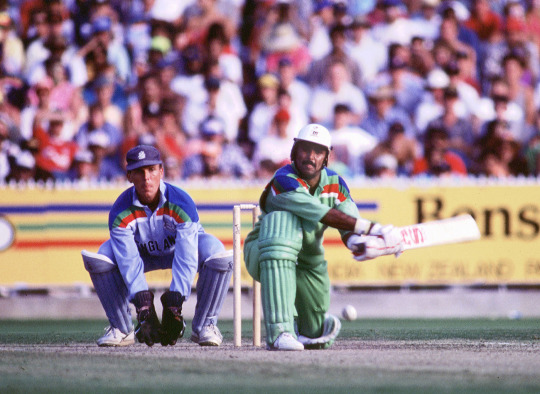
Classic Karachi-Nous: Legend Mohammad Javed Miandad in the 1992 Cricket World Cup Final against England, Melbourne Cricket Ground, Melbourne, Australia. March 25, 1992. Photograph David Munden/© Getty Images
The Jugaaroo! Cheeky, Tough and Masters of Improvisation: How Does Karachi Produce The Batsmen It Does?
Cricketers, like the rest of us, are often perceived to be products of the places they grew up in. Mumbai has a reputation for producing khadoos players, while Hyderabad is popularly regarded as being a nursery for wristy artists, Yorkshire's are dour, while Melbourne's won't give you an inch. Karachi, meanwhile, is said to breed all of these traits into its cricketers: they are inventive, competitive, combative, relishing times when their backs are to the wall, and always looking to grab the game by the scruff of its neck.
— Ahmer Naqvi | Published: June 2, 2016
On March 7, 2015, Pakistan met South Africa in a must-win match at the World Cup. They decided to open with Sarfraz Ahmed. Until then in the tournament, Sarfraz had sat warming the bench - to much criticism - as Pakistan chose to play Umar Akmal as a makeshift wicketkeeper in a bid to bolster the batting. The management had little faith in Sarfraz's batting, especially as an opener, though he had had previous success in the position. Here he was sent to open against the best bowling attack the team had faced so far.
He was beaten inside the line by Dale Steyn the very first ball he faced. "The way I was beaten, it gave me an idea," Sarfraz told me when we met in Karachi a few weeks after the World Cup. "Unless I move forward to meet [the next ball], this gig is going to be up, as the pitch was difficult and the conditions were overcast. So I understood that even if he bowls a sharp bouncer, I could be proactive, as I was ready for him."
Sarfraz started batting out of his crease, shuffling, shifting and sliding effortlessly across it, and eventually scored an entertaining 49. That helped Pakistan to their most authoritative start in the tournament against a major side.
For the casual observer, Sarfraz's daring improv style bore some resemblance to the exciting new strain of batting that livened up the tournament; for this Pakistan side it was an anomaly. Like transistor radios in the age of the internet, this team was composed of batsmen suited to an earlier, forgotten era of cricket. In that light, Sarfraz's innings prolonged the lineage of a distinct strain of Pakistani cricketers.
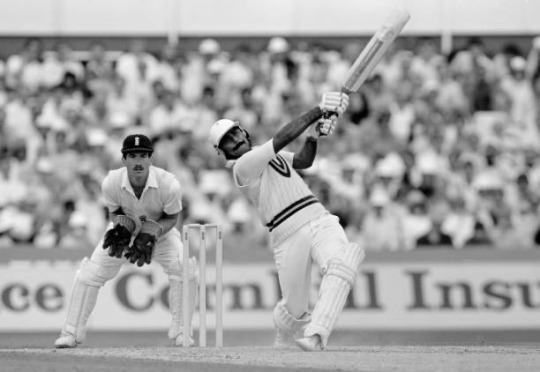
This type of batsman isn't unique to Pakistan, but the Pakistanis who fit it are most likely to be from Karachi. Think of Moin Khan and, to some extent, Rashid Latif. Before them, Asif Mujtaba, and well before them Mushtaq Mohammad and Asif Iqbal, and between them the man who fleshed out the prototype himself, Javed Miandad.
What they had in common was a non-traditional, lateral approach to finding solutions. They looked to generate new ideas. The question was whether this capacity was in some way linked to the city they all hailed from - was there something about growing up in Karachi that conditioned their response? Perhaps this was romanticism - trying to find a reflection of the city I was born in within the game that I loved. But it seemed relevant that when one thought of, for example, the reverse sweep, the advent of proactive running, or counterintuitive strategies, there was always a someone from Karachi involved.
A List of the World's Largest Cities includes several Test centres in the subcontinent. Some, like Lahore and Delhi, are ancient cities with long and grand histories. Some, like Mumbai or Kolkata, are products of colonialism but with a contiguous link to their older pasts.
Cricket's great cities absorb young players and rationalise their approaches. If there is anything unique about Karachi, it is that its tumult has thrown up these players
From having been essentially a fishing village, Karachi was completely transformed by the end of colonialism. So much so that Imran Aslam, a renowned journalist and Karachi resident, says of it: "[It is] a city by the sea [which] has no sea culture, because the entire population here is either Ganga Jamni [from the Gangetic plains of northern India] or from the mountains. You don't get lobsters here, nobody really eats seafood, and you don't see any sailors. It's a city which has no dwellers of its own anymore."
The birth of Pakistan turned Karachi not only into the new capital but also the destination of millions of refugees and migrants, who arrived as much for ideology as for survival. The states of northern India were home to many of the Muslim elites who led the movements for the creation of Pakistan. As such, Karachi was seen as the crystallisation of an idea. The explosiveness of the city's growth soon outstripped the state's ability to realise this idea, and in the decades since, endemic violence has crippled it further.
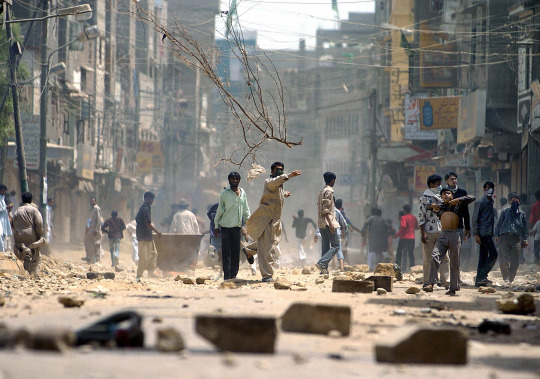
Pakistan's financial hub has withstood decades of civil unrest and tension © Getty Images
Yet it has remained the country's industrial and financial hub as well as its major port. In his book on Karachi, the French author Laurent Gayer describes the city's tense, contradictory equilibrium as an "ordered disorder", and hits at the larger question of Karachi: "How has this city subjected to violent escalation and polarisation… avoided a fully-fledged explosion?" Gayer asks this in the context of the last three decades, when the pervasive levels of violence truly began, but as his book makes clear, the idea of the ordered disorder took root in the city's post-partition development.
Karachi has always been the most consistently tumultuous city in the country. Over time it has given rise to a specific response from its citizens: "rather than coping with crisis," Gayer writes, "they have learned to cope in crisis". Survival instincts are honed that much sharper here.
It manifests itself in a couple of ways. One, as Moin Khan put it to me, is an inner competitiveness. "You are even told at home about the need for healthy competition, and it's very important - if you don't make someone your competitor, then who are you competing with?"
It also brings an urgency and practicality to all tasks, as Rashid Latif illustrated to me through an example of two salesmen. "I take a salesman [outside Karachi] and I tell him, go and do this thing and come back. On his way he will go home and his amma will tell him that she has given the daughter's dupatta to the dyers, so could he please pick it up on his way, but when he gets there the dyer says he'll have it by the evening. So now the salesman figures he is hungry and gets something to eat and it will be evening before he returns to you. In Karachi, you tell him, 'Go do this' and he will go, get it done and come back."
That was not apparent in the cricket immediately. For the first few decades after 1947, Karachi's main source of quality cricketers was its elite, colonial-era schools. They had access to the best facilities and established traditions, and played eagerly contested tournaments. The schoolboy cricketer, particularly one born to Muhajir (or immigrant, to describe those who moved to Pakistan during and after partition) families looking to establish themselves in a new land, was cast with certain expectations and incumbent responsibilities.
Over time Karachi has given rise to a specific response from its citizens: rather than coping with crisis, they have learned to cope in crisis
The consummate product of the school circuit was Hanif Mohammad, and until the 1970s he represented the ultimate ideal of a Karachi batsman. His 337 in Barbados was testament to a young, determined force that refused to give in. Little wonder then that the country, and particularly those sharing his recent migrant past, saw so much of themselves in that effort. It was an innings defined by grit, as the sunburnt layers of skin on his face from 16 hours at the crease testified.
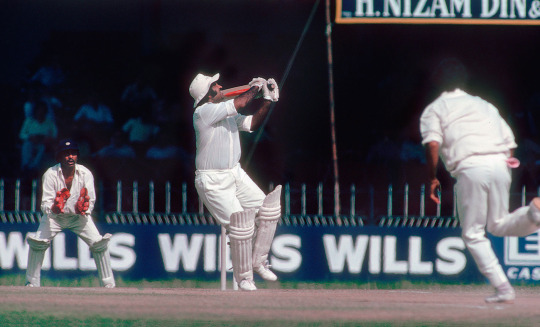
Toughened in Karachi: Mushtaq Mohammad, batting during the 1978-79 Test series against India, was known for his innovative strokeplay and back-to-the-wall performances Patrick Eagar/© Getty Images
However, things would begin to change for both the city and its cricket. Faced with a constantly restive population that defied the state's directives, Ayub Khan, Pakistan's first military dictator, decided in 1960 to move the capital from Karachi. The city continued to attract economic migrants from across the country, becoming simultaneously wealthier but also more unruly. Its centre gyrated to foreign bands and discos and bars, while its peripheries grew rapidly and informally, with the state too overwhelmed to keep up. It was inevitable that cricket would change, and by the '70s the conditions were in place for a new type of batsman to emerge.
Tariq Alam had just completed his matriculation exams in the early '70s when Pakistan's domestic cricket began to induct department sides, such as those of banks, in their first-class set-up. Alam's club had organised a match against a department side where they were set 270-odd to chase and had lost three or four wickets. Keeping with his burgeoning reputation on the local circuit, he walked out and scored a hundred, leading his team to victory. His innings impressed the opponent's sports in-charge, who offered him a spot in the side and a job at the company. Alam was dazed by the offer.
"I was in matric then and I didn't know anything about anything. I just looked at him and said, 'What are you saying?'" he told me in Karachi late last year.
Some seasoned pros urged him to say yes, and Alam headed home to tell his mother and older brother. He remembers being frightened by the turn of events, but his similarly surprised elders quickly realised that he had been offered a job before he had even got to college, and they decided this was the best way forward.
What it meant was that boys from middle-class families could pursue cricket as a serious profession. It meant that playing for clubs could land you a stable job, and in a city driven by the need to survive, it suddenly gave cricket legitimacy in the eyes of a new class of people.
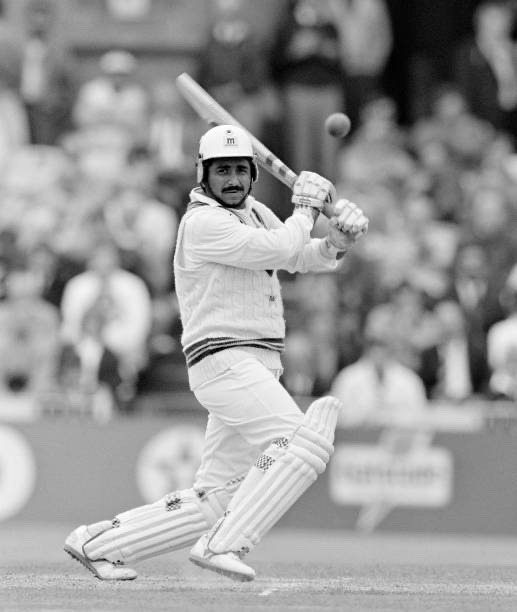
Javed Miandad
While these changes were sweeping through the domestic game, the national team was also changing in decisive ways - both in terms of how it played and how much it was paid. Led by Mushtaq Mohammad, Hanif's younger brother, a new generation of cricketers emerged. They played extensively on the English county circuit, and were attuned to a professional approach to the game and to the competitiveness that came with it. Mushtaq captained a team that provided the template for the modern, unquiet brand of Pakistani cricket - confident, explosive and mercurial.
The apogee of this reinvigoration came, fittingly, in Karachi and against India in 1978. The Indian captain, Bishan Singh Bedi, had already watched Pakistan romp to an improbable win chasing at six an over in the final session of the previous Test, in Lahore. In Karachi the target was stiffer. Pakistan needed 164 to win in 100 minutes, and Bedi was taking few chances, banishing almost his entire field to the boundary. The tactic did not faze Imran Khan, who kept going for, and pulling off, big hits near the end. But what made that chase memorable was how two batsmen chose not to defy Bedi's tactics but to use them against him.
Promoted by Mushtaq, Asif Iqbal and Miandad put on 97 in nine overs, and they did so by tapping the ball instead of blasting it, and running with an aggression unknown to cricket then. Both batsmen were capable of hitting boundaries, but the decision to go for the smarter choice lit up the imaginations of those watching. A small clip online captures their impish assault, in which they pinched doubles and stole byes off dazed fielders. It was, as Zaheer Abbas would later observe, "one-day running but ahead of its time".
Javed Miandad
Miandad's exploits, demeanour and intelligence captured all the qualities that we seemed to identify with the city
But that particular style of batting had already taken root in Karachi's club circuit. Alam, father of Pakistan international Fawad, made quite a name for himself on the club scene - crowds of thousands are said to have flocked to watch club matches in the '70s, and he was often one of the main attractions. An increase in the number of matches exposed players to all sorts of situations, with limited time often requiring a new batting approach.
A certain kind of batsman came to be lionised, one now recognised as a prototype of the ODI finisher. "My batting position, in the middle order, is one where when you arrive at the crease the match situation has become apparent," Alam told me. "From there you have to make sure that you complete your turn at the crease. I only regard someone as a batsman [if he] can take the match with him and return having finished it. If you make 30-40 and get out, then those runs are useless for the team."
The obvious subtext to this approach was a desire for heroism, but one that only took place as a subset of the team's glory - Alam dismissed those batsmen who play for the "Wah wah" of a few dashing strokes. What was crucial was the ability to take the situation by the scruff of the neck and drag the team to its finish. In Urdu, Alam said "match ko pakar ke chalna", or, to grab hold of the game and go along with it. It was an especially resonant phrase.
For example, Moin, whom I met in the sprawling office of his eponymous cricket academy, used a similar phrase to define great batsmen. "Whenever you looked at the great batsmen of the past, it would seem that game ko chala rahe hain khud [they are running the game by themselves], and everything else would be a function of them."
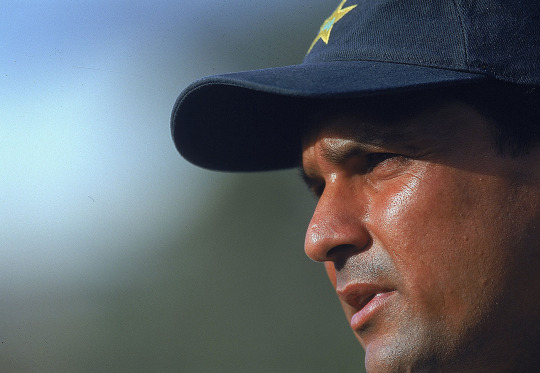
Moin Khan: "You are even told at home about the need for healthy competition - if you don't make someone your competitor, then who are you competing with?" © Getty Images
For modern fans, venerating finishers isn't out of the ordinary. But where nowadays those runs are scored increasingly in boundaries, this type of batsman would use subtler, less bludgeoning methods. Not that there is less risk in this approach. Risk-taking, as Moin explained, is intrinsic to the Karachi approach. "One who doesn't take a risk is caught between two stools. You have to take a risk for your own success. And when you do take a risk, then your approach is always positive."
It is what he did with his running between the wickets, when he felt he had to keep the other team on their toes. "There's a chance in that - sometimes you can make the error, sometimes the fielder will. But until you put pressure on the fielder he won't fumble… and if you're waiting that if he fumbles then only I'll run - no! You have to make him fumble. You know how they say, 'Make it happen'? You have to play with the other's mind."
Jugaar Is A popular Urdu And Hindi Word That Wikipedia Defines As An "Innovative Fix or A Simple Work-Around". A person employing such methods is often referred to as a jugaaroo, which when you think about it really means someone who is good at lateral thinking or at finding solutions that circumvent traditional logic and norms. The rationale behind this piece was that Karachi had a rich tradition of the jugaaroo batsman.
Like transistor radios in the age of the internet, Pakistan's team of 2015 was composed of batsmen suited to an earlier, forgotten era of cricket
The cricketers I spoke to focused very little on the jugaar aspect of batting - they were keen to speak instead about the meaning or purpose of batting rather than the process of it. But the meaning they ascribed to batting also gave away its connection with the approach: they saw themselves as the little guy, the outsider who lacked the privileges that came to others; forever the little guy punching above his weight, goading the opposition and pretending he can bully the bullies, right till he is actually doing so.
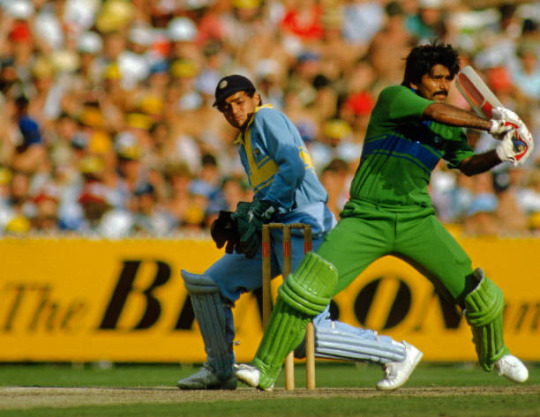
Javed Miandad against India
Imran Aslam had a wonderful quip that perfectly unlocks why the country's largest, richest city would see itself as the little guy or the outsider. Describing the politics - both of cricket and the nation - in Pakistan's two power centres, he says: "When you go to Lahore, they say to you, 'Listen, there's a conspiracy going on against me. You just see, there's a lot of politics going on.' In Karachi, the first conversation is always about injustice."
The word ziyaati - injustice - came up, unprompted, in just about every interview, and it reflects the view that those based in Karachi are outside the system, one that will always seek to attack and marginalise them. The ideal response, then, is to fight back using one's own basic resources, and rely on ideas that exist outside of the norms - in essence, the definition of jugaar.
The longer I spent thinking about this, the more it seemed like Miandad represented the canonical version of the Karachi approach to batting. His exploits, demeanour and intelligence captured all the qualities that we seemed to identify with the city. As Rob Smyth once wrote of him:
"In a sense, all batsmen are doomed. They walk to the crease knowing that their innings is finite, and that it could end at any moment. It takes a very special person to relish that situation, but that's how Javed Miandad played. He had the mentality of a fugitive, content to live on his wits no matter how great the risks. In fact, he needed those risks in order to thrive. The anarchy stimulated him."
(As such, there are certain Karachiites who take a perverse pleasure in riding the city's constant rush of adrenaline. Some friends of mine lived near MA Jinnah Road, one of the city's most symbolic avenues, home to many protests that frequently descend into riots. Describing their hobby as "mob management", they would often look to lead and direct those setting tyres on fire, breaking windows and stoning passing cars. The trick, and the thrill, was to escape before someone realised and the violence was directed at the mob managers.)
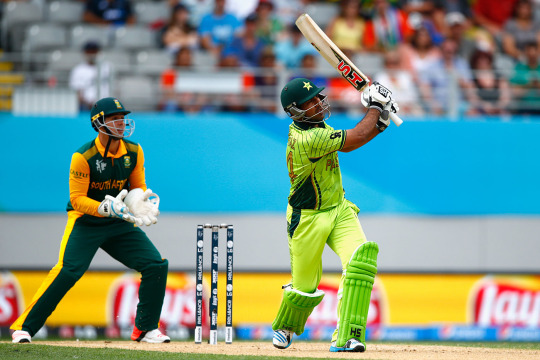
In the modern era, Sarfraz Ahmed's batting has most closely epitomised the Karachi way, as during his 49 against South Africa in Auckland in 2015 © Getty Images
Yet Miandad also transcended this category because he was far too good a batsman, too blessed with skill and ability to be truly considered just a jugaaroo. By design, this approach comes to those who are not as gifted and must find other ways. Think of the innovation that came naturally to Mushtaq, who lacked at least the technique of Hanif. Rather than be daunted, he was creative, experimenting with pinch-hitters like Imran or sending Iqbal to open, and most of all with the reverse sweep, which he lays claim to having invented. That had come in a club game in England in 1964. The problem was Fred Titmus bowling on middle and leg with a midwicket and square leg in place; Mushtaq's solution was to reverse sweep through the vacant point- and third-man region.
Mushtaq had several classic back-to-the-wall performances in his career. A similar sense of crisis inspired Iqbal as well, who was never seen as a top-order batsman and yet was consistently reliable when it was toughest to bat. Osman Samiuddin calculates in The Unquiet Ones that 18 of Iqbal's 23 scores of 50-plus came "with Pakistan in deep strife".
You glimpse it in others from the city too; in Asif Mujtaba's two impossible ODI chases against Australia, sealing a win and a tie with a last-ball six; in Moin's audacious sweeping of Glenn McGrath, a shot he admitted he never dared practise against his own bowlers in the nets; in Sarfraz's heist in Sharjah.
None of this is to claim that such players are unique to Karachi, but it is often true that in a sport as traditionalist as cricket, such players often emerge from the hinterlands, from far-flung areas with self-taught techniques. Cricket's great cities on the other hand soon absorb young players into the sport's institutions, rationalising their approaches. If there is anything unique about Karachi, it is that its tumult and sway have created a propensity for throwing up these players.
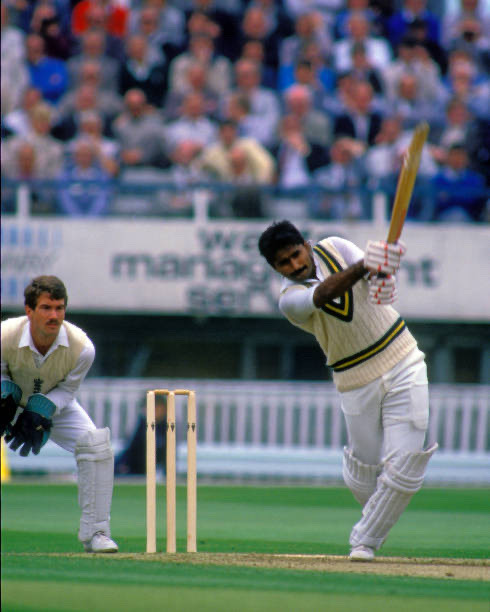
It is difficult to see what the future holds for this sort of player. The opportunities of tape-ball cricket, the city's great love and invention, as well as the techniques it imparts, have affected the ability of local batsmen to adjust to regular hard-ball cricket. One of the links between Rashid's and Moin's era and that of Sarfraz is Shahid Afridi, whose influence on local batting ideals cannot be discounted. More significantly, batting all over the world has undergone a significant evolution, one that Pakistan has missed out on. International cricket is now gone, a further impact on the exposure afforded to local players. Then again, those are exactly the kind of odds against which Karachi batting might thrive.
— Ahmer Naqvi is a Freelance Writer who works for the Music Website Patari. He would like to acknowledge Safieh Shah's help in writing this piece.
— The Cricket Monthly
0 notes
Text
0 notes
Photo
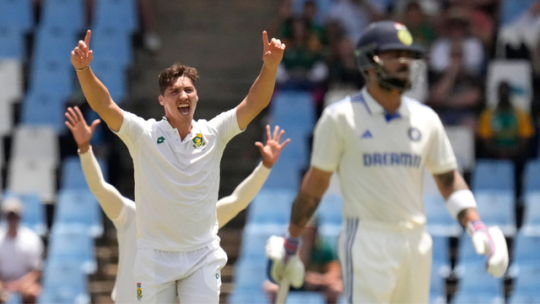
Watch Swapping Dale Steyn for Roger Federer, how Nandre Burger turned South Africa cricket’s ‘subsequent huge factor’ - Google Cricket News
0 notes
Link
Top Social Media Trends from Cricket World The social media was once again buzzing... #usa #uk
0 notes
Text
SA20 Welcomes AB De Villiers As Brand Ambassador

SA20 League Commissioner: SA20, South Africa’s T20 cricket league, welcomes Proteas legend AB de Villiers as the official brand ambassador for Season 2.His cricketing expertise and charisma mark a pivotal moment in the League’s quest to become the world's most popular cricket league outside of India. Season 2 kicks off on January 10, 2024, featuring 34 matches over 4 weeks, showcasing elite domestic and international players from the six global franchises. Speaking on the appointment of AB de Villiers as the brand ambassador, SA20 League Commissioner, Graeme Smith said, "We are thrilled to have AB de Villiers join us as the brand ambassador for Betway SA20 Season 2. AB’s exceptional cricketing talent and magnetic personality make him the perfect fit for our league. His involvement will undoubtedly elevate the League’s status, both on and off the field. AB’s passion for the game and his ability to connect with fans align perfectly with our vision for Betway SA20. We believe his presence will not only inspire players but also engage cricket enthusiasts across the globe, helping us achieve unprecedented success. We look forward to a fantastic season ahead, with AB playing a crucial role in making it a resounding triumph." AB de Villiers said, “It’s an honour to be associated with Betway SA20. It embodies a pioneering vision for South African cricket, with the potential to illuminate the global cricketing stage. SA20's remarkable talent and international reach provide a platform to showcase the finest of South African cricket, propelling it to unprecedented levels." AB de Villiers, who has consistently exhibited his dedication on the field, is all set to be the flag-bearer of the league. He will be working very closely with the management team of SA20 to help strengthen the global fanbase of the League and reinforce the League’s brand across key strategic markets of India and the UK. AB de Villiers will be joined by an illustrious ensemble of South African cricket legends, including Herschelle Gibbs, Allan Donald, Dale Steyn, Mark Boucher, and Robin Peterson. These cricket luminaries will actively contribute to the League's mission, playing a pivotal role in advancing South African cricket to new heights. Their wealth of experience, both on and off the field, adds a dynamic dimension to the League's objectives, marked by excellence and a shared commitment to elevating the stature of South African cricket on the global stage. Read the full article
#AllanDonald#BetwaySA20#BetwaySA20Season#DaleSteyn#GraemeSmith#HerschelleGibbs#MarkBoucher#NewDelhi#RobinPeterson#SA20LeagueCommissioner#SouthAfrica#SouthAfrican
0 notes
Link
Dale Steyn took a poignant trip down memory lane, revisiting one of the painful chapters in South Africa‘s cricket history—the 2015 World Cup semifinal against New Zealand at Eden Park in Auckland.In this rain-curtailed 43-over encounter, the Proteas, despite setting a formidable target of 297, suffered a devastating loss by four wickets. The hopes of reaching the final at the Melbourne Cricket Ground were crushed when Grant Elliott smashed Steyn for a six off the penultimate ball, reducing several South African players to tears.Dale Steyn recalls South Africa’s 2015 World Cup semifinal defeatReflecting on the aftermath, Steyn disclosed the emotional toll the defeat took on the team. It took nearly 24 hours for the players to cope with the heartbreak, and the subject became a taboo in subsequent discussions.“I think we dealt with it really well in that 24 hours, and then we went home and everyone went our own way. But getting together the next time as a South African team and walking back to the dressing room, I felt like we hadn’t spoken about what happened few months ago. And we needed to make sure that that elephant was out of that room. It was certainly still in the room for what I felt was a long time,” Steyn was quoted as saying by ESPNcricinfo.Also READ: Australia’s captain Pat Cummins discusses potential participation in IPL 2024Steyn’s professional approach and smiling through adversitySteyn, being one of the senior players, shared how he maintained professionalism, wearing a smile despite the internal disappointment.“I went into the dressing room and I sat down and I was like ‘this is where you have to be the true professional you are. You are a senior player. I went around to some of the younger guys, the Quinton de Kocks. Morne [Morkel] was incredibly upset, visibly upset even on TV. But I thought to the public eye, when you’re on TV, you have to maintain that professional image. Put a smile on your face, be professional when you’ve been beaten in a big game,” the 40-year-old concluded.South Africa’s semi final challenge against AustraliaAfter a subpar performance in 2019, South Africa find themselves in the ODI World Cup semi-finals once again, gearing up to face Pat Cummins‘ Australia on Thursday, November 16, at the iconic Eden Gardens in Kolkata.Also READ: ODI World Cup 2023: Here’s the list of commentators for the India vs New Zealand semi-final clash in Mumbai https://crickettimes.com/wp-content/uploads/2023/11/Dale-Steyn-opens-up-about-South-Africas-painful-defeat-against-New-Zealand-in-the-semi-final.webp #Dale #Steyn #opens #South #Africas #heartbreaking #defeat #Zealand #semifinal #ODI #World #Cup
0 notes
Text
Unveiling a Remarkable Dream: Roelof Van Der Merwe's Thrilling Journey Towards a Shared Cricket World Cup Dream
Roelof van der Merwe, a former player for the South Africa cricket team alongside Dale Steyn, AB de Villiers, and Jacques Kallis, has qualified for the World Cup as a member of the Netherlands team. Van der Merwe, who is now 38 years old, is among a group of only 16 individuals who have represented two different countries in cricket. He played in 13 One Day Internationals (ODIs) for South Africa…
View On WordPress
0 notes
Text
South Africa legend Dale Steyn predicts the top wicket-taker of ODI World Cup 2023
Former South African cricketing legend Dale Steyn, renowned for his exceptional bowling prowess, has made his prediction for the leading wicket-taker of the upcoming ICC ODI World Cup. The marquee event will take place in India from October 5 to November 19. The defending champion England will square off against New Zealand in the tournament’s opener at the iconic Narendra Modi Stadium in…

View On WordPress
0 notes
Text
Unveiling Haris Rauf's Ultimate Bowling Idol: A Former Royal Challengers Bangalore Speedster
Pakistan pacer Haris Rauf has named former South Africa and ex-Royal Challengers Bangalore bowler Dale Steyn as his all-time favorite bowler. Rauf admires Steyn’s aggression and tries to replicate his celebration style after taking wickets. In a video uploaded by ICC, Rauf expressed his admiration for Steyn, stating that he has been following him since he started playing cricket. While Rauf…

View On WordPress
0 notes
Text
Unveiling Haris Rauf's Ultimate Bowling Idol: A Former Royal Challengers Bangalore Speedster
Pakistan pacer Haris Rauf has named former South Africa and ex-Royal Challengers Bangalore bowler Dale Steyn as his all-time favorite bowler. Rauf admires Steyn’s aggression and tries to replicate his celebration style after taking wickets. In a video uploaded by ICC, Rauf expressed his admiration for Steyn, stating that he has been following him since he started playing cricket. While Rauf…

View On WordPress
0 notes